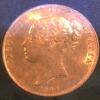|
|
The current range of books. Click the image above to see them on Amazon (printed and Kindle format). More info on coinpublications.com |
|
|

Dont read this if you have not slabbed a cgs coin
By
PWA 1967, in TPG Discussions
 Coinpublications.com
Coinpublications.com